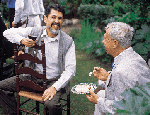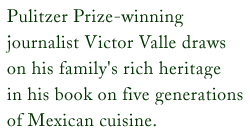

|
 |
|||

|
 |
||
| by Juan R. Palomo | |||
|
uno se come 
FOOD
one eats -Victor Valle |
Victor Valle (GJ81) has always wanted to do what he wasn't supposed to be doing. As a young boy in Los Angeles, he
wanted to go into his mother's kitchen when she was cooking something special. So he did. As a reporter at the Los Angeles Times, he wanted to write poetry. So he wrote and published a collection of his poems. And as a journalism professor at California State Polytechnic University, Valle wanted to write about food, and he wanted to make some forceful points about Latino culture while he was at it. So he did. In almost every case, he did so while others were telling him he shouldn't or couldn't. "Get out of here," Valle recalled his mother telling him as he looked on while she cooked. "Boys are not supposed to be in the kitchen." "But I wanted to know," he said. "I wanted to know how certain dishes were prepared, and the only way I could learn was by watching my mother, so I stayed." When he and his wife, Mary Lau Valle, decided to write a book about cuisine Mexican cuisine based on family recipes handed down through several generations, some of his peers at Cal Poly's journalism department discouraged him. "They were trying to tell me that I should be doing academic work," he said. "They didn't think I should be writing about food, because that is women's work. There was a gender bias there that I didn't expect. But I'm a journalist, which means that I have a natural curiosity about a lot of things. I don't put limits on where it should take me. I want to know, and I assume other people also want to know." Besides, Valle argued, to Latinos and many other cultures, the topic of food is serious, to say the least. Anyone who doubts this need only read Like Water for Chocolate, the bestselling book by Mexican author Laura Esquivel, or watch the equally popular movie based on the film. "Serious discussion about food makes complete sense to a lot of people, but in this academic culture, they just didn't get it," Valle said. "Food is just a metaphor." He eventually solved his dilemma by switching to the ethnic studies department, where he was encouraged to pursue his interest in food and his ancestors' recipes. "I was selfish and stubborn," he explained. Valle and his wife first came up with the idea for Recipe of Memory (The New Press, New York, 1995) during his graduate studies at the Medill School of Journalism. The two were living in Englehart Hall, where one day they started leafing through a collection of recipes written by Catalina Clementina Vargas, his grandmother Delfina's aunt. The recipes some original, some copied from other sources came from Guadalajara, the Valles' ancestral home, and ended up in Los Angeles, where hard times forced the family to migrate in the early 1900s. His own aunt had given him the collection shortly before the Valles left for Northwestern. "Here," Aunt Estela had told him. "Take these with you, ya que vas a ser periodista (now that you're going to be a journalist)." As he leafed through the collection, he started to understand that the gift was not as innocent as it seemed. "She had plans for me," Valle said. "I began to realize that I had had that food, and something began to click. It occurred to me that this would be something I might want to write about. It was a strange kind of realization." About that time, Mary Lau Valle (who is of Chinese and Mexican descent and also comes from a long line of great cooks) began to experiment with some of the recipes in an adult education class she was teaching. "Suddenly the lights went on in our heads," said Victor Valle: a book. Not having had any experience with the publishing world, they sought out people who had, including famed Mexican cookbook author Diane Kennedy. Still, publishing a book at that point in his life was not in Valle's long-term plans. His first goal was to finish school and enter journalism to learn the discipline needed to be a writer. "I wanted to use journalism as an apprenticeship, as many other writers have done," he said. So before moving into the academic world, Valle joined the Los Angeles Times, where he worked for eight years. During that period, he received several journalism awards, including a shared Pulitzer Prize in 1984 for team reporting on the Southern California Latino community. Putting the cookbook together was not easy. Not only did it have to be translated from Spanish, but in most cases the Valles had to do a lot of detective work and experimentation to flesh out Aunt Catalina's hand-written directions. They realized early on that the recipes were incomplete. "They were written by the lady of the house for the help to remind them how to cook a certain dish," Valle explained. "She didn't write all the details because she assumed they would already know them. It wasn't like today where every little thing is written down." So the couple had to fill in the blanks, trying various methods for a recipe until it seemed right. On occasion, they would take the dish to an older relative for him or her to taste. The Valles also traveled to Guadalajara, where they interviewed people, some of them very old women, about some surprising topics, such as monetary units. In certain cases, a recipe called for a real's [reh-AHL] worth of a certain ingredient, but the real is no longer a unit of Mexican currency. The result of the Valles' labor is a rich collection of mouth-watering recipes ranging from prickly pear sorbet and squab on saffron rice to stuffed catfish and a soup made from the common weed verdolaga (purslane). And the names of some of the dishes are often as interesting as the ingredients. There's "Rabbit in the Garden," "Drunken Chicken" and "Violent Consommé." It's a book redolent with aromas and rekindles memories for anyone who grew up in a Mexican family. In fact, memories both powered and navigated the book. "I was always aware that my family ate differently, and I was proud of it," Valle said. "In a sense, my growing up was in total contrast to Richard Rodriguez [a California writer who wrote Hunger of Memory]. He used to cover the pots that held his mother's cooking when his white friends came over, but I was always proud to show it off. If I had tried to cover the pots, my hands would have been slapped." For Valle, writing about food was also a great way to write about a people, about their lives, customs and history. In many ways, too, the book is a history of his family, and the recipes helped him tell that story, warts and all, with whole chapters devoted to his ancestors in between recipes. The main characters are almost all women. "They had to be," Valle explained. "Not just because they were the ones who cooked, but because they were the ones who wrote it all down." In part, Valle has also written a social commentary, with heartfelt opinions on many of today's hot issues, including bilingual education and immigration. A quick look at the index will find "racism," "religion" and "repatriation" between "purslane" and "restaurants." The epilogue ("A Cuisine without Borders") is an unabashed attack on the racism that Valle believes distorted most early Mexican American cookbooks. Often, the recipes were labeled Spanish, as if calling them Mexican would render them less palatable. Valle writes with passion about what he maintains is the undeniable mezticaje (the cultural fusion of European, Native American, Asian and African cultures) in the United States. Since the cookbook, he has co-authored another work about the enormous mestizo influence in Los Angeles, called Latino Metropolis, which will be published by the University of Minnesota Press next year. "I would be lying if I could predict when or how the mestizo cultural order contained in the recipes will move from our kitchens into the public square or into the election booth," he wrote in Recipe of Memory. "But I do know this mestizo culture and cuisine is intrinsically valid now, regardless if it is ever understood or validated by the national culture." Valle said he had little choice but to venture into tricky areas if he wanted to write an honest book about Mexican cuisine. "I didn't want to get too heavy or mean-spirited, but there were certain arguments that had to be taken into account," he said. "When you talk about Mexican food, you are talking about how the people construct their world. You have to look at food as a cultural artifact. You can't talk about Latino food as a whole without also dealing with mestizo culture." Merely focusing on the ingredients in Mexican cooking simply "objectifies" the food, Valle concluded. "When we talk about food, we talk about memory and politics. Our food isn't just about ingredients. Our food is like a family conversation where no one agrees. It's a dialogue." Juan R. Palomo is a trade association media relations representative in Washington, D.C., and a columnist for USA Today. | ||

| |||

| |||

Elotes Tatemados When corn is roasted whole and unshucked, the green husks not only seal in heat, they steam into each ear a delicate, smoky sweetness perfectly accented with a pinch of salt, a squeeze of lime and a dusting of lip-stinging chile. There are no strict measurements or roasting times for this recipe. It is all a matter of taste and timing.
Ingredients
Preparation Reprinted from Recipe of Memory (The New Press, New York, 1995) | |||
| Jim Krantz photos reprinted with the authorization of Country Home magazine, Meredith Corp., August 1998 | |||